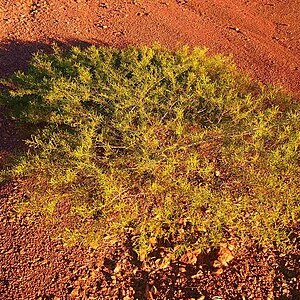Sprawling, semi-prostrate, normally flat-topped, horizontally-branched, resinous, glabrous shrub 0.3–1 (–1.5) m high and spreading 1–3 (–4–5) m across. Branchlets variably tuberculate, obscurely ribbed. New shoots viscid. Phyllodes solitary at nodes or sometimes in clusters of 2 or 3, commonly shallowly to moderately curved upwards (often curving from near the base), sometimes straight, terete to compressed, rarely flat, 2–6 (–7) cm long, 0.5–1 mm wide, coriaceous, glaucous when mature, usually tuberculate, obscurely multistriate; gland usually 1, inconspicuous, 2.8–13 mm above pulvinus. Spikes 2–4.5 cm long, erect, golden; peduncles 10–30 (–40) mm long. Flowers 5-merous; calyx 0.5–1 mm long, dissected for ⅔–¾ of length. Pods erect, linear but narrowed towards base, flat, 2–7.7 cm long, 2.5–5 (–6) mm wide, woody, viscid and fragrant (especially when young), dark brown, with oblique nerves, opening elastically from the ±hooked apex (valves recurved following dehiscence); margins thick and pale coloured; with discrete seed-partitions. Seeds oblique to almost longitudinal, laterally compressed, 2.8–5.5 mm long, chestnut to brown; areole light brown to brown, with pale halo; funicle-aril straight and narrowly turbinate.
More
A small spreading shrub. It is flat topped and about 1 m tall. The stems are slender and round in cross section. The leaves (phyllodes) are 2-3 cm long by 0.1-0.3 cm wide. They are thin and pointed. They are rough and have glands along them. The flowers are like rods 2-3 cm long. They are a deep orange yellow. The flower stalks are sticky. Flowers occur singly in the angles of leaves. The pods are 2-5 cm long by 0.4-0.6 cm wide. They are flat. They are also sticky and have a prominent edge. They open from the top and curve backwards. The seeds are arranged diagonally.
Grows in skeletal, red loamy sand or sand on laterite or quartzite, on slopes or ridges, near creeks, inland sand dunes or rocky plains, in open woodland, shrubland or grassland with eucalypts, acacias and spinifex.
More
Grows in skeletal, red loamy sand or sand on laterite or quartzite, on slopes or ridges, near creeks, inland sand dunes or rocky plains, in open woodland, shrubland or grassland with eucalypts, acacias and spinifex.
It occurs on gravely soils. It needs a sunny position and required good drainage.
This species is very attractive when in flower and has horticultural potential for inland gardens. It is used widely in the Pilbara, Western Australia, for mine site rehabilitation.
More
Grubs are collected from the roots.


